HI5017: Impact of Managerial Accounting System in Manufacturing
VerifiedAdded on 2022/11/07
|14
|3634
|221
Report
AI Summary
This report evaluates the impact of Management Accounting Systems (MAS) in a multinational manufacturing company, using case studies. It begins by examining the performance of MAS in contemporary organizations, highlighting tools such as Activity-Based Costing (ABC), Total Quality Management (TQM), and Value Chain Analysis. The report compares the outcomes of a multinational manufacturing company with a medium-sized production company, focusing on the implementation and changes brought about by ABC. It explores the relevance of MAS in decision-making, performance evaluation, and navigating competitive business environments, emphasizing the importance of adapting MAS to specific organizational needs for enhanced efficiency and profitability. The analysis also covers the role of MAS in improving cross-functional perspectives and ensuring better control over manufacturing, marketing, and distribution processes.
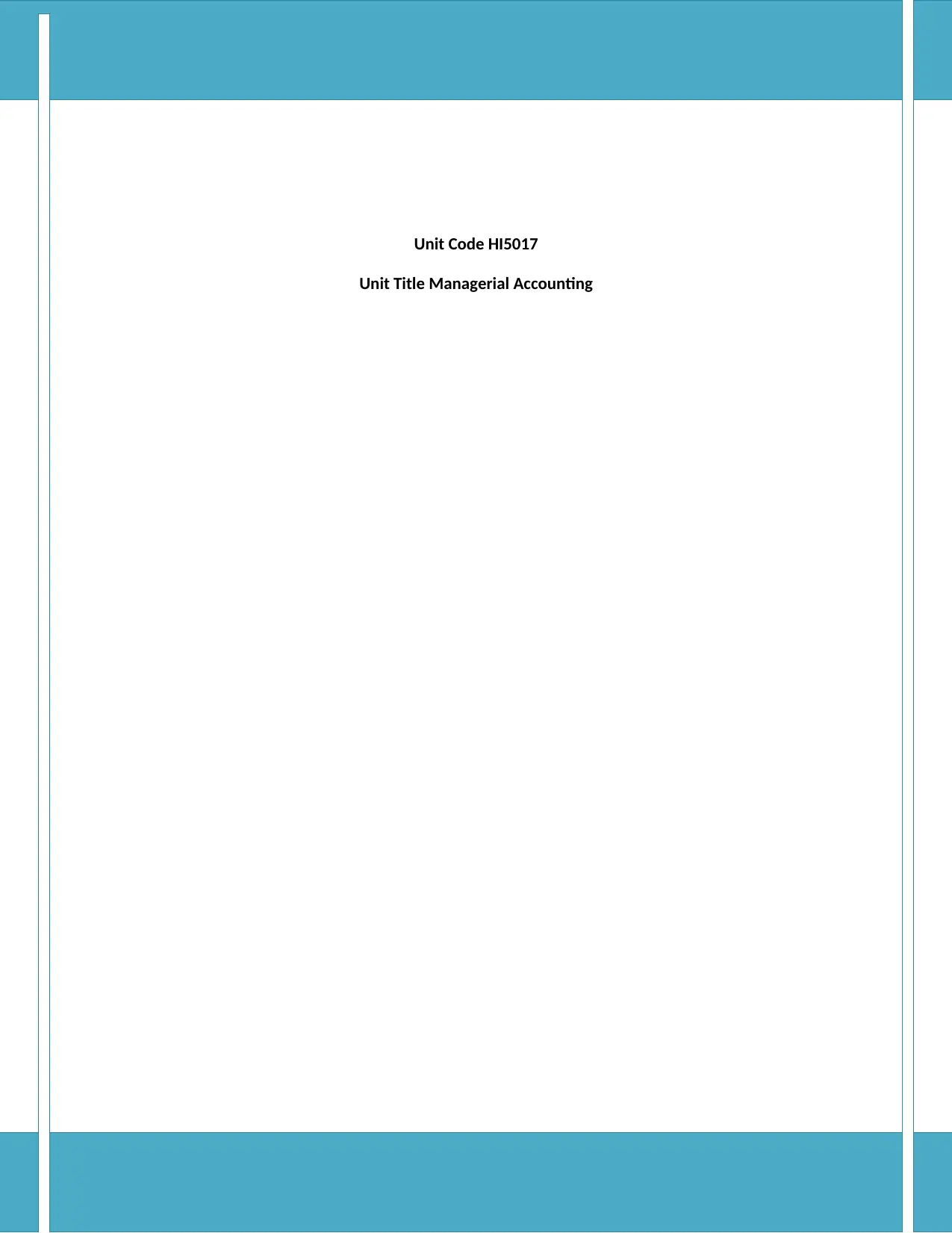
Unit Code HI5017
Unit Title Managerial Accounting
Unit Title Managerial Accounting
Paraphrase This Document
Need a fresh take? Get an instant paraphrase of this document with our AI Paraphraser
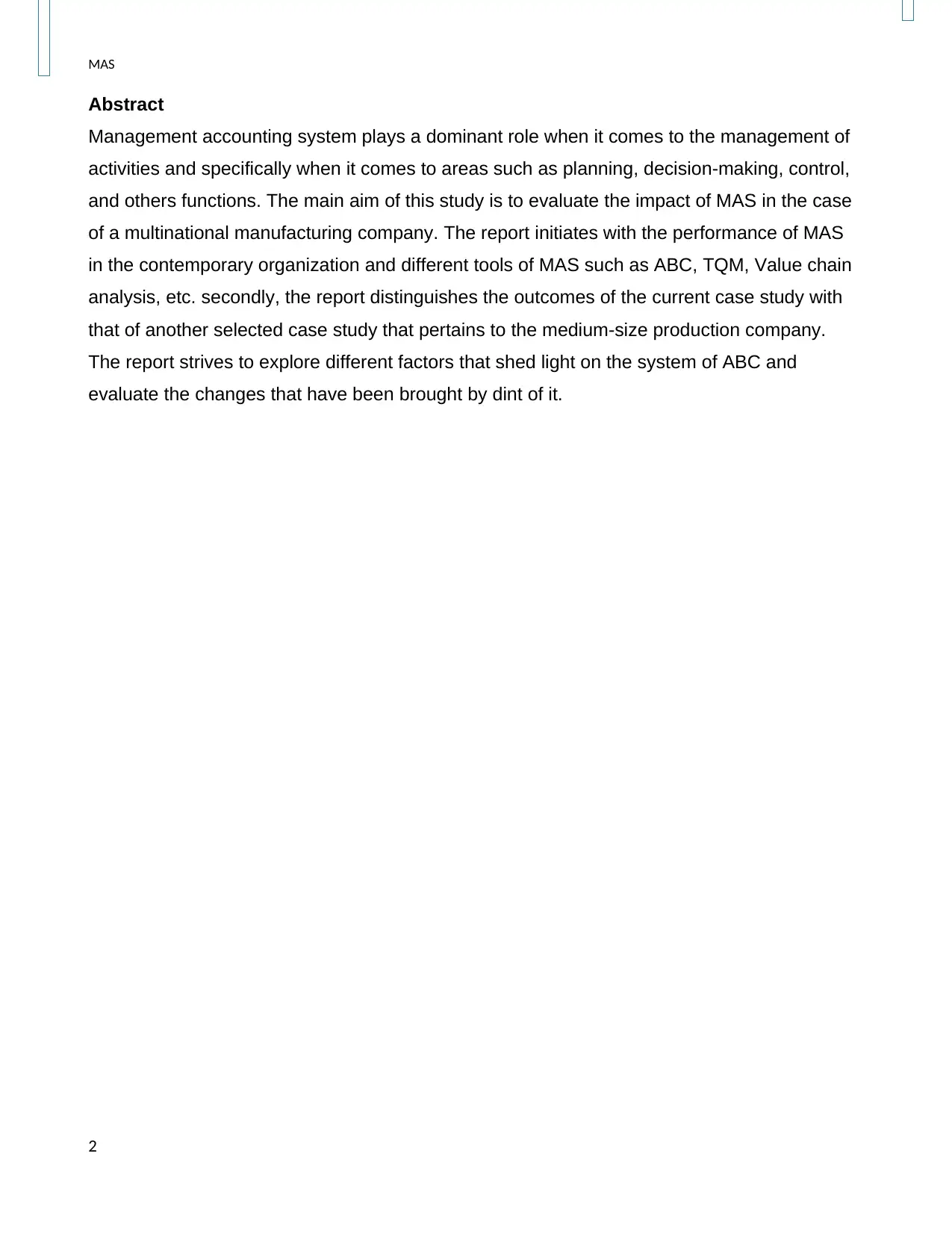
MAS
Abstract
Management accounting system plays a dominant role when it comes to the management of
activities and specifically when it comes to areas such as planning, decision-making, control,
and others functions. The main aim of this study is to evaluate the impact of MAS in the case
of a multinational manufacturing company. The report initiates with the performance of MAS
in the contemporary organization and different tools of MAS such as ABC, TQM, Value chain
analysis, etc. secondly, the report distinguishes the outcomes of the current case study with
that of another selected case study that pertains to the medium-size production company.
The report strives to explore different factors that shed light on the system of ABC and
evaluate the changes that have been brought by dint of it.
2
Abstract
Management accounting system plays a dominant role when it comes to the management of
activities and specifically when it comes to areas such as planning, decision-making, control,
and others functions. The main aim of this study is to evaluate the impact of MAS in the case
of a multinational manufacturing company. The report initiates with the performance of MAS
in the contemporary organization and different tools of MAS such as ABC, TQM, Value chain
analysis, etc. secondly, the report distinguishes the outcomes of the current case study with
that of another selected case study that pertains to the medium-size production company.
The report strives to explore different factors that shed light on the system of ABC and
evaluate the changes that have been brought by dint of it.
2
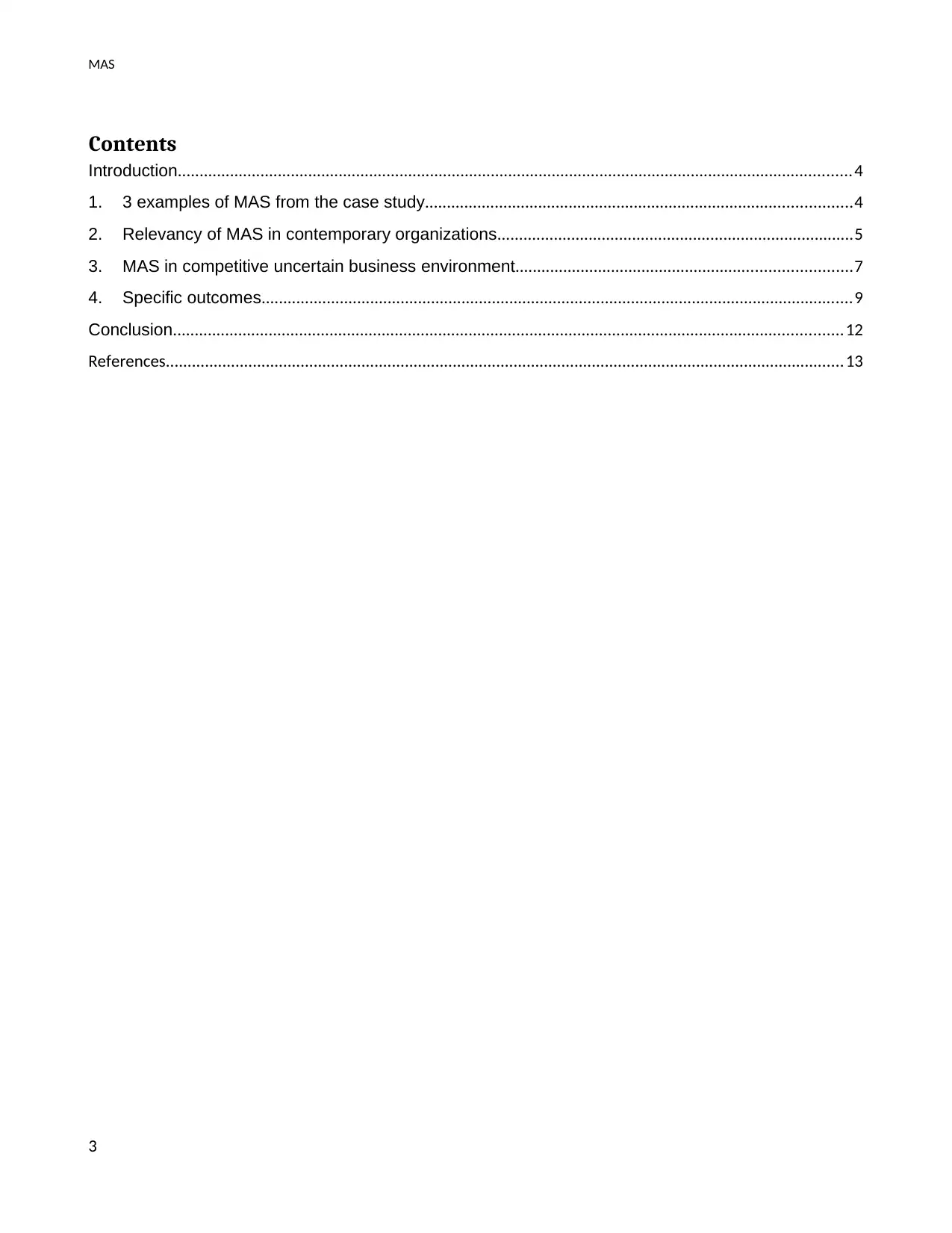
MAS
Contents
Introduction...........................................................................................................................................................4
1. 3 examples of MAS from the case study..................................................................................................4
2. Relevancy of MAS in contemporary organizations..................................................................................5
3. MAS in competitive uncertain business environment.............................................................................7
4. Specific outcomes........................................................................................................................................9
Conclusion..........................................................................................................................................................12
References............................................................................................................................................................13
3
Contents
Introduction...........................................................................................................................................................4
1. 3 examples of MAS from the case study..................................................................................................4
2. Relevancy of MAS in contemporary organizations..................................................................................5
3. MAS in competitive uncertain business environment.............................................................................7
4. Specific outcomes........................................................................................................................................9
Conclusion..........................................................................................................................................................12
References............................................................................................................................................................13
3
⊘ This is a preview!⊘
Do you want full access?
Subscribe today to unlock all pages.

Trusted by 1+ million students worldwide
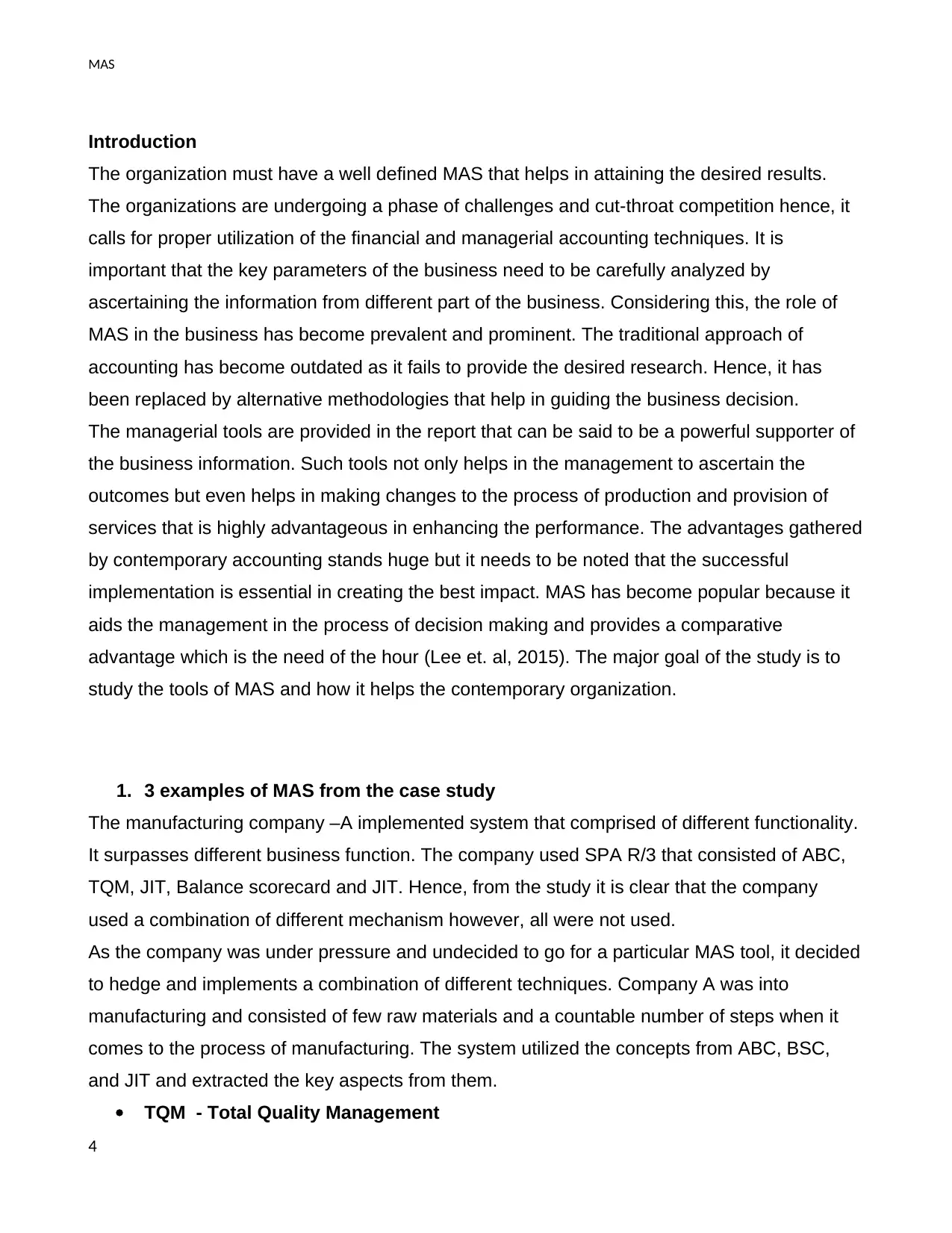
MAS
Introduction
The organization must have a well defined MAS that helps in attaining the desired results.
The organizations are undergoing a phase of challenges and cut-throat competition hence, it
calls for proper utilization of the financial and managerial accounting techniques. It is
important that the key parameters of the business need to be carefully analyzed by
ascertaining the information from different part of the business. Considering this, the role of
MAS in the business has become prevalent and prominent. The traditional approach of
accounting has become outdated as it fails to provide the desired research. Hence, it has
been replaced by alternative methodologies that help in guiding the business decision.
The managerial tools are provided in the report that can be said to be a powerful supporter of
the business information. Such tools not only helps in the management to ascertain the
outcomes but even helps in making changes to the process of production and provision of
services that is highly advantageous in enhancing the performance. The advantages gathered
by contemporary accounting stands huge but it needs to be noted that the successful
implementation is essential in creating the best impact. MAS has become popular because it
aids the management in the process of decision making and provides a comparative
advantage which is the need of the hour (Lee et. al, 2015). The major goal of the study is to
study the tools of MAS and how it helps the contemporary organization.
1. 3 examples of MAS from the case study
The manufacturing company –A implemented system that comprised of different functionality.
It surpasses different business function. The company used SPA R/3 that consisted of ABC,
TQM, JIT, Balance scorecard and JIT. Hence, from the study it is clear that the company
used a combination of different mechanism however, all were not used.
As the company was under pressure and undecided to go for a particular MAS tool, it decided
to hedge and implements a combination of different techniques. Company A was into
manufacturing and consisted of few raw materials and a countable number of steps when it
comes to the process of manufacturing. The system utilized the concepts from ABC, BSC,
and JIT and extracted the key aspects from them.
TQM - Total Quality Management
4
Introduction
The organization must have a well defined MAS that helps in attaining the desired results.
The organizations are undergoing a phase of challenges and cut-throat competition hence, it
calls for proper utilization of the financial and managerial accounting techniques. It is
important that the key parameters of the business need to be carefully analyzed by
ascertaining the information from different part of the business. Considering this, the role of
MAS in the business has become prevalent and prominent. The traditional approach of
accounting has become outdated as it fails to provide the desired research. Hence, it has
been replaced by alternative methodologies that help in guiding the business decision.
The managerial tools are provided in the report that can be said to be a powerful supporter of
the business information. Such tools not only helps in the management to ascertain the
outcomes but even helps in making changes to the process of production and provision of
services that is highly advantageous in enhancing the performance. The advantages gathered
by contemporary accounting stands huge but it needs to be noted that the successful
implementation is essential in creating the best impact. MAS has become popular because it
aids the management in the process of decision making and provides a comparative
advantage which is the need of the hour (Lee et. al, 2015). The major goal of the study is to
study the tools of MAS and how it helps the contemporary organization.
1. 3 examples of MAS from the case study
The manufacturing company –A implemented system that comprised of different functionality.
It surpasses different business function. The company used SPA R/3 that consisted of ABC,
TQM, JIT, Balance scorecard and JIT. Hence, from the study it is clear that the company
used a combination of different mechanism however, all were not used.
As the company was under pressure and undecided to go for a particular MAS tool, it decided
to hedge and implements a combination of different techniques. Company A was into
manufacturing and consisted of few raw materials and a countable number of steps when it
comes to the process of manufacturing. The system utilized the concepts from ABC, BSC,
and JIT and extracted the key aspects from them.
TQM - Total Quality Management
4
Paraphrase This Document
Need a fresh take? Get an instant paraphrase of this document with our AI Paraphraser
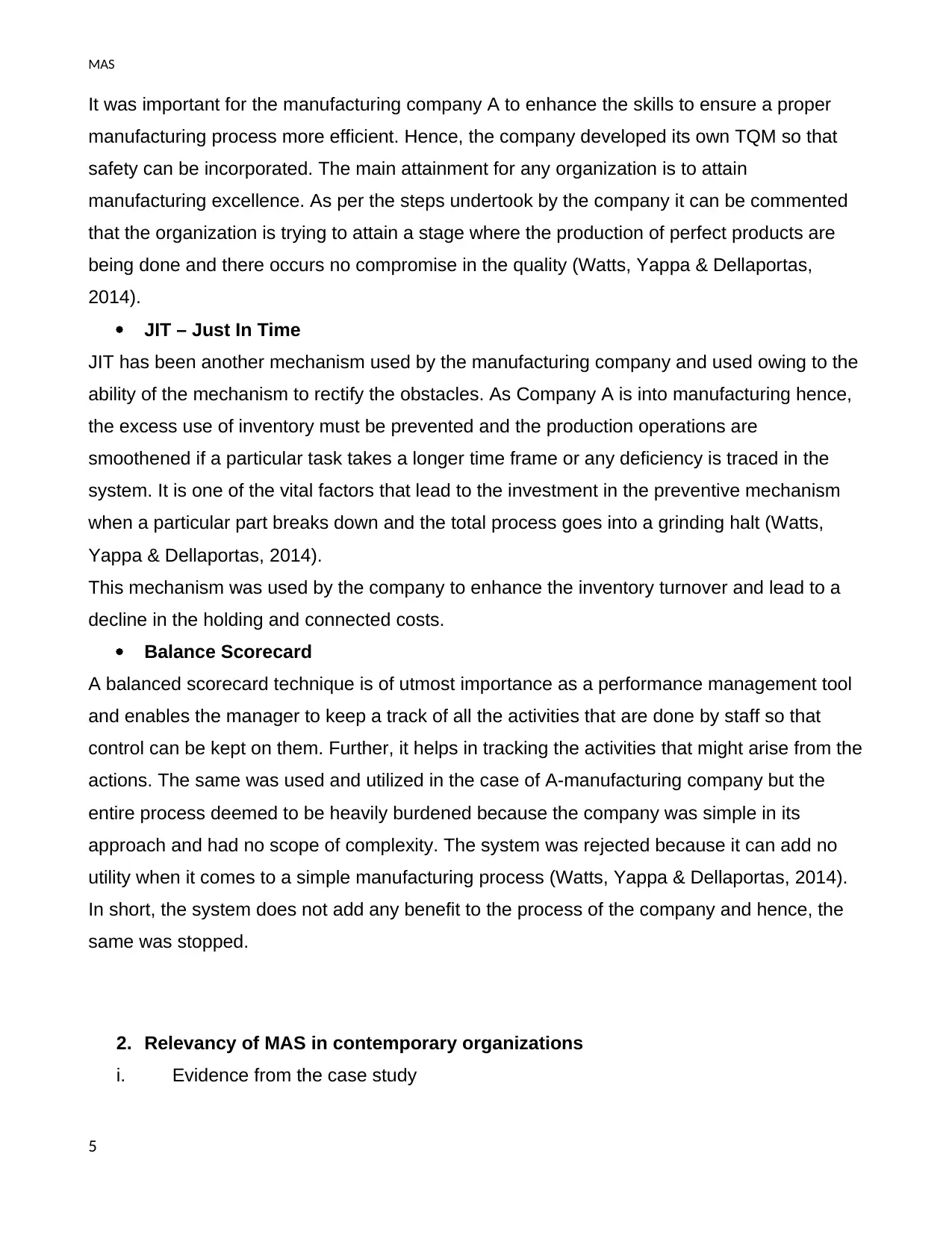
MAS
It was important for the manufacturing company A to enhance the skills to ensure a proper
manufacturing process more efficient. Hence, the company developed its own TQM so that
safety can be incorporated. The main attainment for any organization is to attain
manufacturing excellence. As per the steps undertook by the company it can be commented
that the organization is trying to attain a stage where the production of perfect products are
being done and there occurs no compromise in the quality (Watts, Yappa & Dellaportas,
2014).
JIT – Just In Time
JIT has been another mechanism used by the manufacturing company and used owing to the
ability of the mechanism to rectify the obstacles. As Company A is into manufacturing hence,
the excess use of inventory must be prevented and the production operations are
smoothened if a particular task takes a longer time frame or any deficiency is traced in the
system. It is one of the vital factors that lead to the investment in the preventive mechanism
when a particular part breaks down and the total process goes into a grinding halt (Watts,
Yappa & Dellaportas, 2014).
This mechanism was used by the company to enhance the inventory turnover and lead to a
decline in the holding and connected costs.
Balance Scorecard
A balanced scorecard technique is of utmost importance as a performance management tool
and enables the manager to keep a track of all the activities that are done by staff so that
control can be kept on them. Further, it helps in tracking the activities that might arise from the
actions. The same was used and utilized in the case of A-manufacturing company but the
entire process deemed to be heavily burdened because the company was simple in its
approach and had no scope of complexity. The system was rejected because it can add no
utility when it comes to a simple manufacturing process (Watts, Yappa & Dellaportas, 2014).
In short, the system does not add any benefit to the process of the company and hence, the
same was stopped.
2. Relevancy of MAS in contemporary organizations
i. Evidence from the case study
5
It was important for the manufacturing company A to enhance the skills to ensure a proper
manufacturing process more efficient. Hence, the company developed its own TQM so that
safety can be incorporated. The main attainment for any organization is to attain
manufacturing excellence. As per the steps undertook by the company it can be commented
that the organization is trying to attain a stage where the production of perfect products are
being done and there occurs no compromise in the quality (Watts, Yappa & Dellaportas,
2014).
JIT – Just In Time
JIT has been another mechanism used by the manufacturing company and used owing to the
ability of the mechanism to rectify the obstacles. As Company A is into manufacturing hence,
the excess use of inventory must be prevented and the production operations are
smoothened if a particular task takes a longer time frame or any deficiency is traced in the
system. It is one of the vital factors that lead to the investment in the preventive mechanism
when a particular part breaks down and the total process goes into a grinding halt (Watts,
Yappa & Dellaportas, 2014).
This mechanism was used by the company to enhance the inventory turnover and lead to a
decline in the holding and connected costs.
Balance Scorecard
A balanced scorecard technique is of utmost importance as a performance management tool
and enables the manager to keep a track of all the activities that are done by staff so that
control can be kept on them. Further, it helps in tracking the activities that might arise from the
actions. The same was used and utilized in the case of A-manufacturing company but the
entire process deemed to be heavily burdened because the company was simple in its
approach and had no scope of complexity. The system was rejected because it can add no
utility when it comes to a simple manufacturing process (Watts, Yappa & Dellaportas, 2014).
In short, the system does not add any benefit to the process of the company and hence, the
same was stopped.
2. Relevancy of MAS in contemporary organizations
i. Evidence from the case study
5
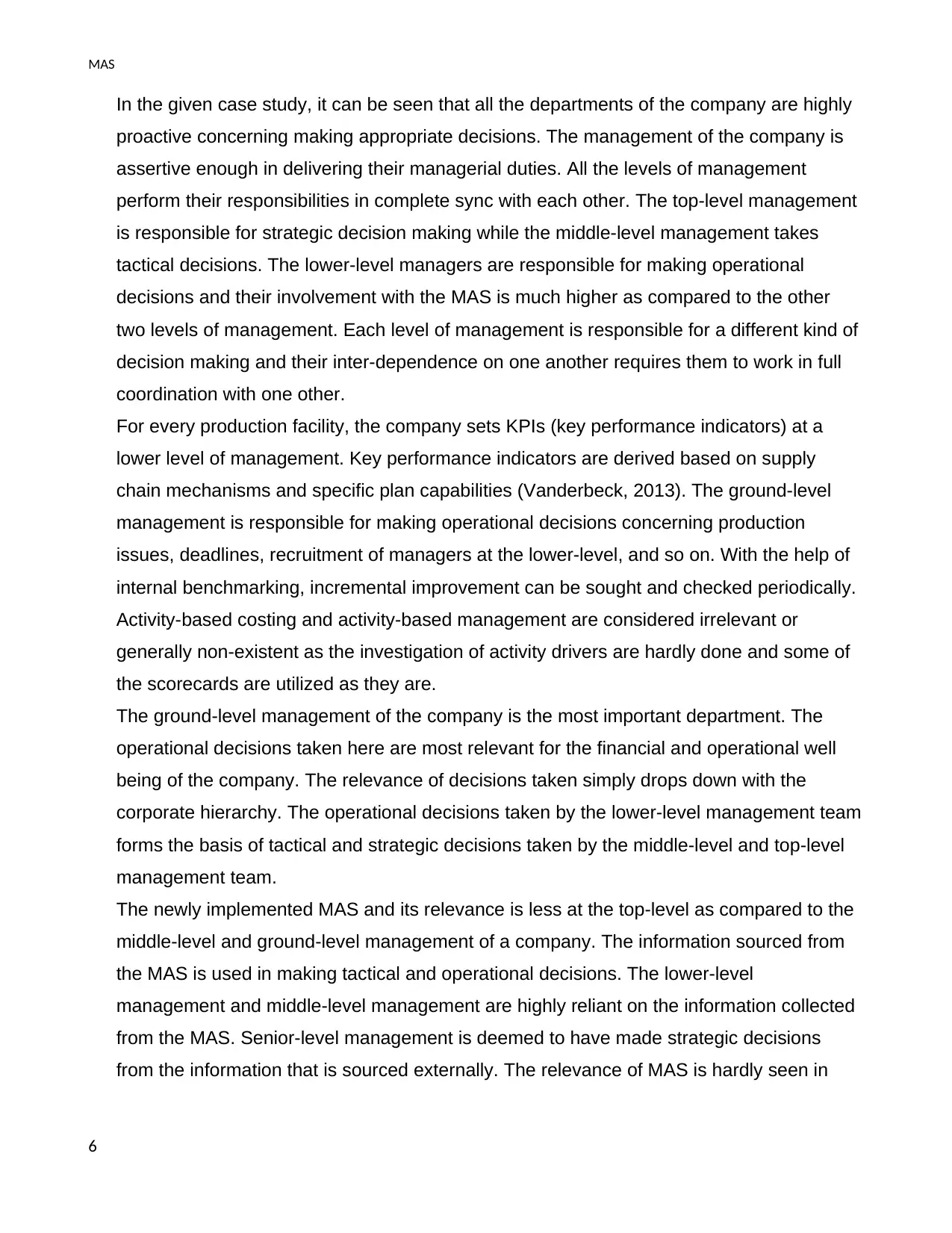
MAS
In the given case study, it can be seen that all the departments of the company are highly
proactive concerning making appropriate decisions. The management of the company is
assertive enough in delivering their managerial duties. All the levels of management
perform their responsibilities in complete sync with each other. The top-level management
is responsible for strategic decision making while the middle-level management takes
tactical decisions. The lower-level managers are responsible for making operational
decisions and their involvement with the MAS is much higher as compared to the other
two levels of management. Each level of management is responsible for a different kind of
decision making and their inter-dependence on one another requires them to work in full
coordination with one other.
For every production facility, the company sets KPIs (key performance indicators) at a
lower level of management. Key performance indicators are derived based on supply
chain mechanisms and specific plan capabilities (Vanderbeck, 2013). The ground-level
management is responsible for making operational decisions concerning production
issues, deadlines, recruitment of managers at the lower-level, and so on. With the help of
internal benchmarking, incremental improvement can be sought and checked periodically.
Activity-based costing and activity-based management are considered irrelevant or
generally non-existent as the investigation of activity drivers are hardly done and some of
the scorecards are utilized as they are.
The ground-level management of the company is the most important department. The
operational decisions taken here are most relevant for the financial and operational well
being of the company. The relevance of decisions taken simply drops down with the
corporate hierarchy. The operational decisions taken by the lower-level management team
forms the basis of tactical and strategic decisions taken by the middle-level and top-level
management team.
The newly implemented MAS and its relevance is less at the top-level as compared to the
middle-level and ground-level management of a company. The information sourced from
the MAS is used in making tactical and operational decisions. The lower-level
management and middle-level management are highly reliant on the information collected
from the MAS. Senior-level management is deemed to have made strategic decisions
from the information that is sourced externally. The relevance of MAS is hardly seen in
6
In the given case study, it can be seen that all the departments of the company are highly
proactive concerning making appropriate decisions. The management of the company is
assertive enough in delivering their managerial duties. All the levels of management
perform their responsibilities in complete sync with each other. The top-level management
is responsible for strategic decision making while the middle-level management takes
tactical decisions. The lower-level managers are responsible for making operational
decisions and their involvement with the MAS is much higher as compared to the other
two levels of management. Each level of management is responsible for a different kind of
decision making and their inter-dependence on one another requires them to work in full
coordination with one other.
For every production facility, the company sets KPIs (key performance indicators) at a
lower level of management. Key performance indicators are derived based on supply
chain mechanisms and specific plan capabilities (Vanderbeck, 2013). The ground-level
management is responsible for making operational decisions concerning production
issues, deadlines, recruitment of managers at the lower-level, and so on. With the help of
internal benchmarking, incremental improvement can be sought and checked periodically.
Activity-based costing and activity-based management are considered irrelevant or
generally non-existent as the investigation of activity drivers are hardly done and some of
the scorecards are utilized as they are.
The ground-level management of the company is the most important department. The
operational decisions taken here are most relevant for the financial and operational well
being of the company. The relevance of decisions taken simply drops down with the
corporate hierarchy. The operational decisions taken by the lower-level management team
forms the basis of tactical and strategic decisions taken by the middle-level and top-level
management team.
The newly implemented MAS and its relevance is less at the top-level as compared to the
middle-level and ground-level management of a company. The information sourced from
the MAS is used in making tactical and operational decisions. The lower-level
management and middle-level management are highly reliant on the information collected
from the MAS. Senior-level management is deemed to have made strategic decisions
from the information that is sourced externally. The relevance of MAS is hardly seen in
6
⊘ This is a preview!⊘
Do you want full access?
Subscribe today to unlock all pages.

Trusted by 1+ million students worldwide
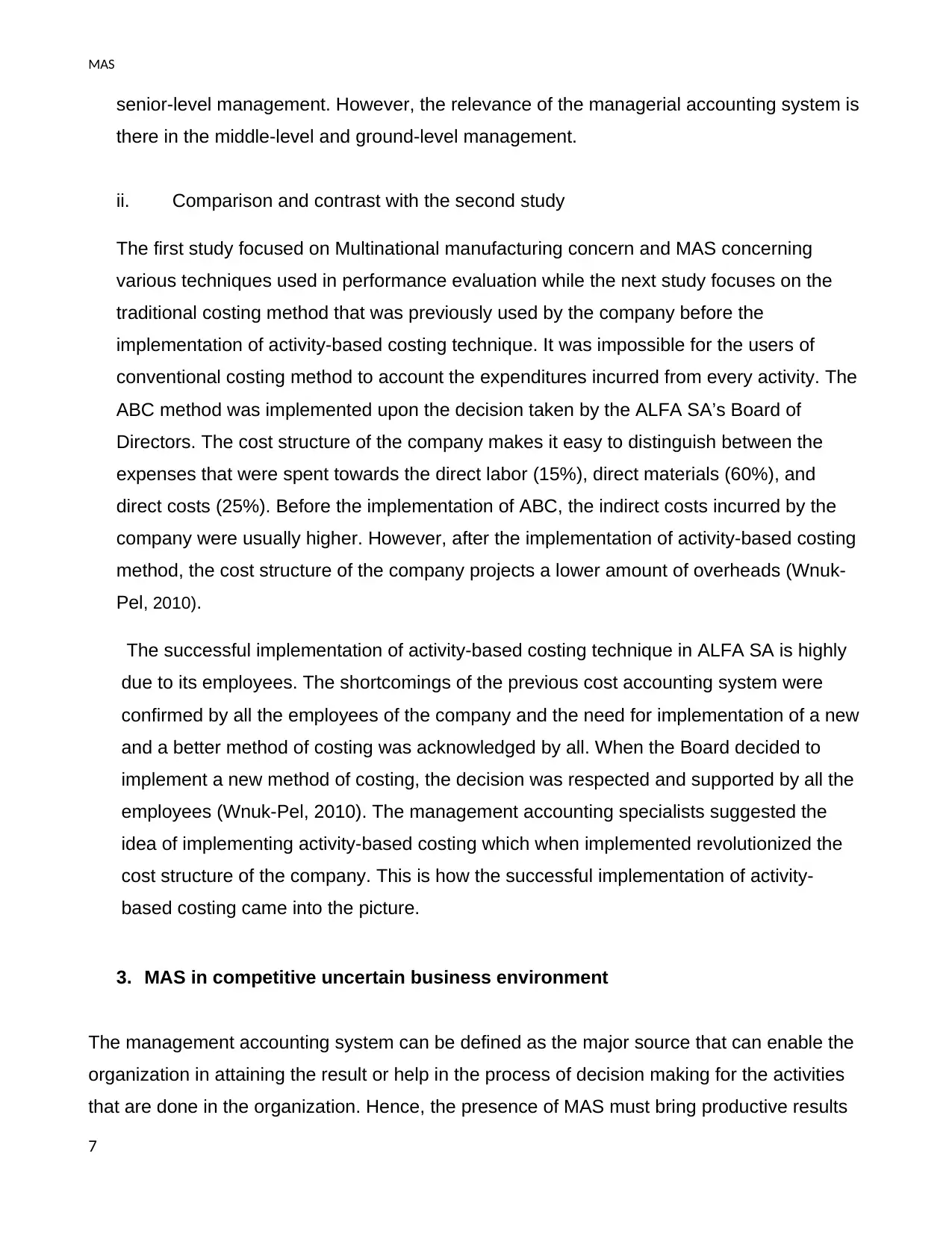
MAS
senior-level management. However, the relevance of the managerial accounting system is
there in the middle-level and ground-level management.
ii. Comparison and contrast with the second study
The first study focused on Multinational manufacturing concern and MAS concerning
various techniques used in performance evaluation while the next study focuses on the
traditional costing method that was previously used by the company before the
implementation of activity-based costing technique. It was impossible for the users of
conventional costing method to account the expenditures incurred from every activity. The
ABC method was implemented upon the decision taken by the ALFA SA’s Board of
Directors. The cost structure of the company makes it easy to distinguish between the
expenses that were spent towards the direct labor (15%), direct materials (60%), and
direct costs (25%). Before the implementation of ABC, the indirect costs incurred by the
company were usually higher. However, after the implementation of activity-based costing
method, the cost structure of the company projects a lower amount of overheads (Wnuk-
Pel, 2010).
The successful implementation of activity-based costing technique in ALFA SA is highly
due to its employees. The shortcomings of the previous cost accounting system were
confirmed by all the employees of the company and the need for implementation of a new
and a better method of costing was acknowledged by all. When the Board decided to
implement a new method of costing, the decision was respected and supported by all the
employees (Wnuk-Pel, 2010). The management accounting specialists suggested the
idea of implementing activity-based costing which when implemented revolutionized the
cost structure of the company. This is how the successful implementation of activity-
based costing came into the picture.
3. MAS in competitive uncertain business environment
The management accounting system can be defined as the major source that can enable the
organization in attaining the result or help in the process of decision making for the activities
that are done in the organization. Hence, the presence of MAS must bring productive results
7
senior-level management. However, the relevance of the managerial accounting system is
there in the middle-level and ground-level management.
ii. Comparison and contrast with the second study
The first study focused on Multinational manufacturing concern and MAS concerning
various techniques used in performance evaluation while the next study focuses on the
traditional costing method that was previously used by the company before the
implementation of activity-based costing technique. It was impossible for the users of
conventional costing method to account the expenditures incurred from every activity. The
ABC method was implemented upon the decision taken by the ALFA SA’s Board of
Directors. The cost structure of the company makes it easy to distinguish between the
expenses that were spent towards the direct labor (15%), direct materials (60%), and
direct costs (25%). Before the implementation of ABC, the indirect costs incurred by the
company were usually higher. However, after the implementation of activity-based costing
method, the cost structure of the company projects a lower amount of overheads (Wnuk-
Pel, 2010).
The successful implementation of activity-based costing technique in ALFA SA is highly
due to its employees. The shortcomings of the previous cost accounting system were
confirmed by all the employees of the company and the need for implementation of a new
and a better method of costing was acknowledged by all. When the Board decided to
implement a new method of costing, the decision was respected and supported by all the
employees (Wnuk-Pel, 2010). The management accounting specialists suggested the
idea of implementing activity-based costing which when implemented revolutionized the
cost structure of the company. This is how the successful implementation of activity-
based costing came into the picture.
3. MAS in competitive uncertain business environment
The management accounting system can be defined as the major source that can enable the
organization in attaining the result or help in the process of decision making for the activities
that are done in the organization. Hence, the presence of MAS must bring productive results
7
Paraphrase This Document
Need a fresh take? Get an instant paraphrase of this document with our AI Paraphraser
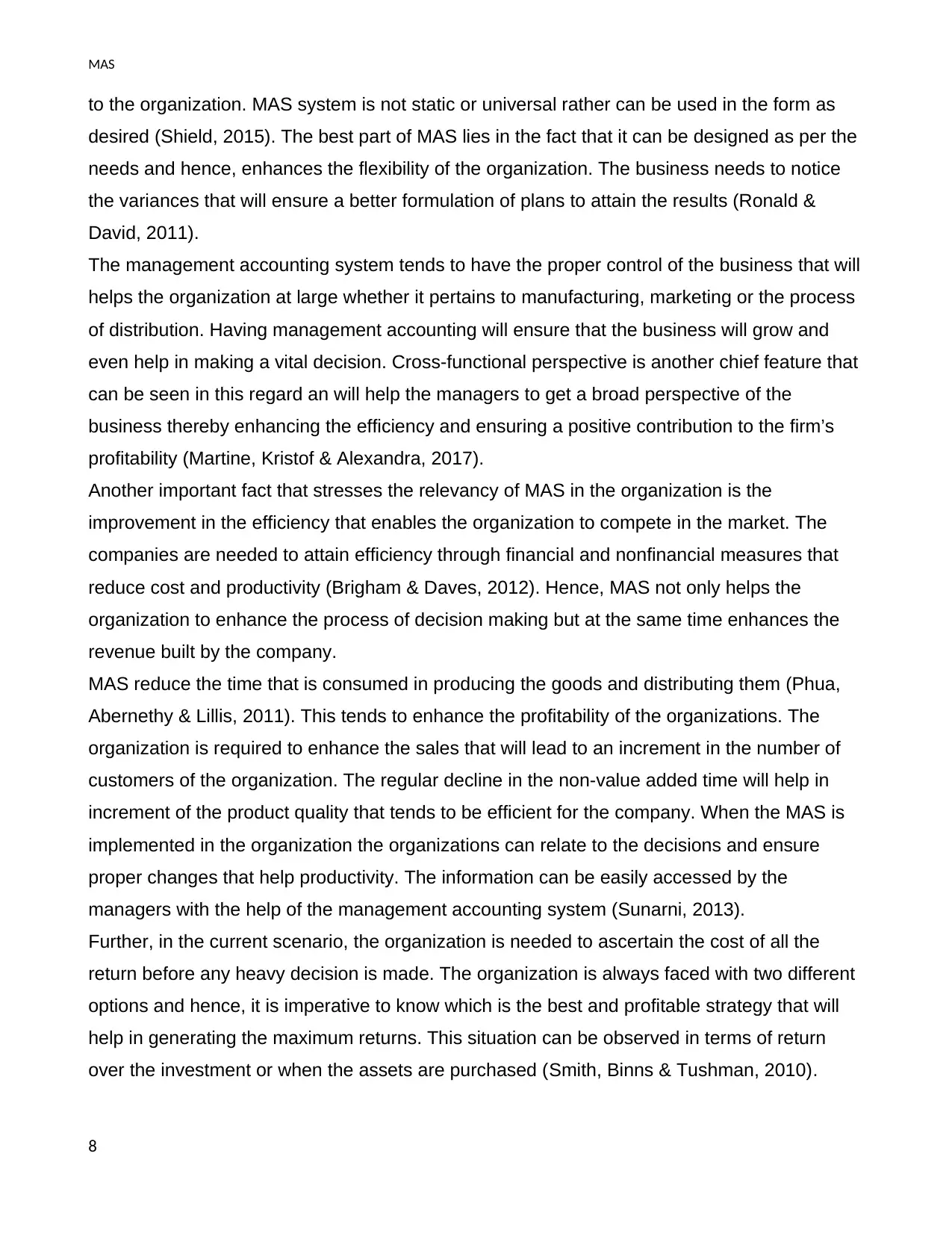
MAS
to the organization. MAS system is not static or universal rather can be used in the form as
desired (Shield, 2015). The best part of MAS lies in the fact that it can be designed as per the
needs and hence, enhances the flexibility of the organization. The business needs to notice
the variances that will ensure a better formulation of plans to attain the results (Ronald &
David, 2011).
The management accounting system tends to have the proper control of the business that will
helps the organization at large whether it pertains to manufacturing, marketing or the process
of distribution. Having management accounting will ensure that the business will grow and
even help in making a vital decision. Cross-functional perspective is another chief feature that
can be seen in this regard an will help the managers to get a broad perspective of the
business thereby enhancing the efficiency and ensuring a positive contribution to the firm’s
profitability (Martine, Kristof & Alexandra, 2017).
Another important fact that stresses the relevancy of MAS in the organization is the
improvement in the efficiency that enables the organization to compete in the market. The
companies are needed to attain efficiency through financial and nonfinancial measures that
reduce cost and productivity (Brigham & Daves, 2012). Hence, MAS not only helps the
organization to enhance the process of decision making but at the same time enhances the
revenue built by the company.
MAS reduce the time that is consumed in producing the goods and distributing them (Phua,
Abernethy & Lillis, 2011). This tends to enhance the profitability of the organizations. The
organization is required to enhance the sales that will lead to an increment in the number of
customers of the organization. The regular decline in the non-value added time will help in
increment of the product quality that tends to be efficient for the company. When the MAS is
implemented in the organization the organizations can relate to the decisions and ensure
proper changes that help productivity. The information can be easily accessed by the
managers with the help of the management accounting system (Sunarni, 2013).
Further, in the current scenario, the organization is needed to ascertain the cost of all the
return before any heavy decision is made. The organization is always faced with two different
options and hence, it is imperative to know which is the best and profitable strategy that will
help in generating the maximum returns. This situation can be observed in terms of return
over the investment or when the assets are purchased (Smith, Binns & Tushman, 2010).
8
to the organization. MAS system is not static or universal rather can be used in the form as
desired (Shield, 2015). The best part of MAS lies in the fact that it can be designed as per the
needs and hence, enhances the flexibility of the organization. The business needs to notice
the variances that will ensure a better formulation of plans to attain the results (Ronald &
David, 2011).
The management accounting system tends to have the proper control of the business that will
helps the organization at large whether it pertains to manufacturing, marketing or the process
of distribution. Having management accounting will ensure that the business will grow and
even help in making a vital decision. Cross-functional perspective is another chief feature that
can be seen in this regard an will help the managers to get a broad perspective of the
business thereby enhancing the efficiency and ensuring a positive contribution to the firm’s
profitability (Martine, Kristof & Alexandra, 2017).
Another important fact that stresses the relevancy of MAS in the organization is the
improvement in the efficiency that enables the organization to compete in the market. The
companies are needed to attain efficiency through financial and nonfinancial measures that
reduce cost and productivity (Brigham & Daves, 2012). Hence, MAS not only helps the
organization to enhance the process of decision making but at the same time enhances the
revenue built by the company.
MAS reduce the time that is consumed in producing the goods and distributing them (Phua,
Abernethy & Lillis, 2011). This tends to enhance the profitability of the organizations. The
organization is required to enhance the sales that will lead to an increment in the number of
customers of the organization. The regular decline in the non-value added time will help in
increment of the product quality that tends to be efficient for the company. When the MAS is
implemented in the organization the organizations can relate to the decisions and ensure
proper changes that help productivity. The information can be easily accessed by the
managers with the help of the management accounting system (Sunarni, 2013).
Further, in the current scenario, the organization is needed to ascertain the cost of all the
return before any heavy decision is made. The organization is always faced with two different
options and hence, it is imperative to know which is the best and profitable strategy that will
help in generating the maximum returns. This situation can be observed in terms of return
over the investment or when the assets are purchased (Smith, Binns & Tushman, 2010).
8
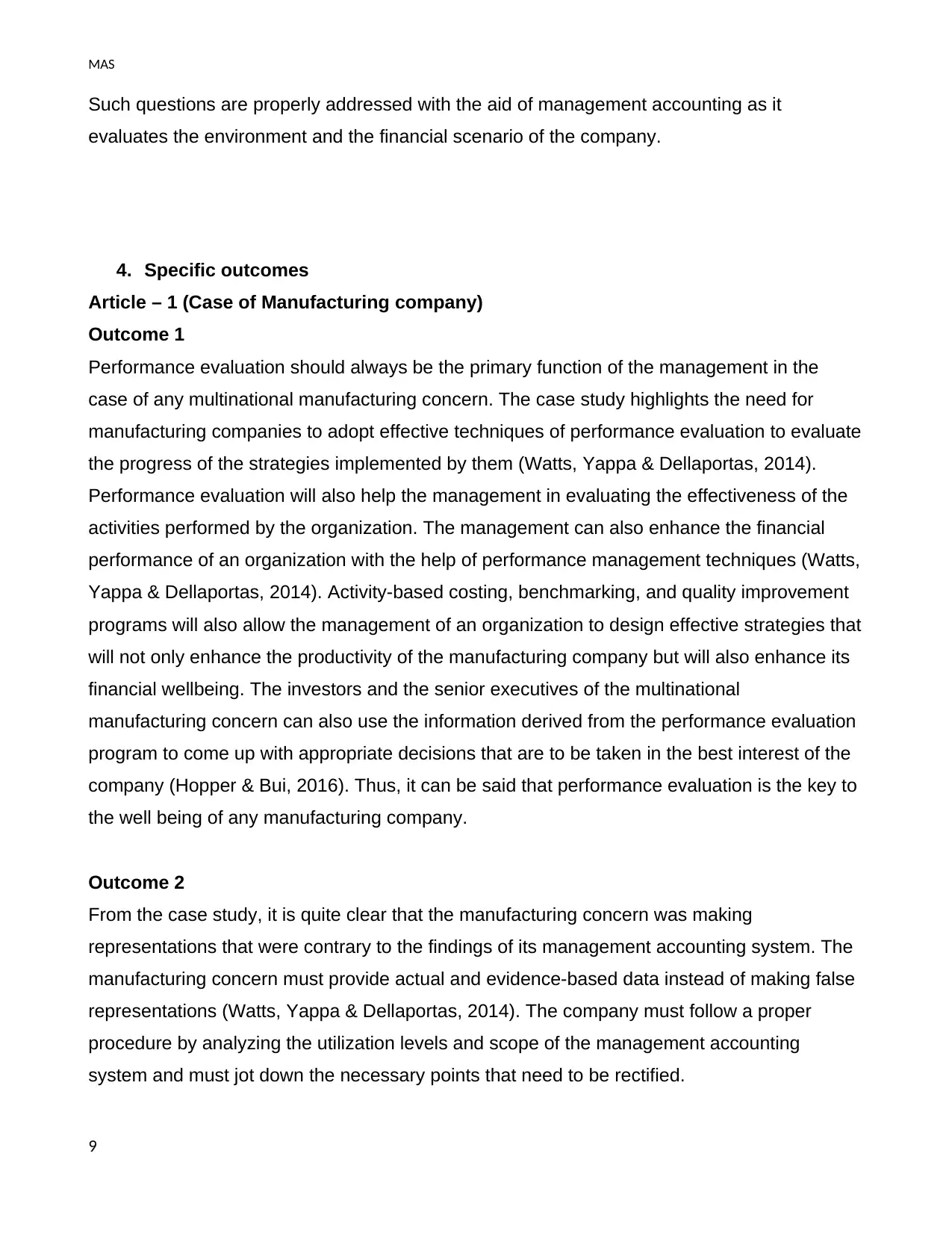
MAS
Such questions are properly addressed with the aid of management accounting as it
evaluates the environment and the financial scenario of the company.
4. Specific outcomes
Article – 1 (Case of Manufacturing company)
Outcome 1
Performance evaluation should always be the primary function of the management in the
case of any multinational manufacturing concern. The case study highlights the need for
manufacturing companies to adopt effective techniques of performance evaluation to evaluate
the progress of the strategies implemented by them (Watts, Yappa & Dellaportas, 2014).
Performance evaluation will also help the management in evaluating the effectiveness of the
activities performed by the organization. The management can also enhance the financial
performance of an organization with the help of performance management techniques (Watts,
Yappa & Dellaportas, 2014). Activity-based costing, benchmarking, and quality improvement
programs will also allow the management of an organization to design effective strategies that
will not only enhance the productivity of the manufacturing company but will also enhance its
financial wellbeing. The investors and the senior executives of the multinational
manufacturing concern can also use the information derived from the performance evaluation
program to come up with appropriate decisions that are to be taken in the best interest of the
company (Hopper & Bui, 2016). Thus, it can be said that performance evaluation is the key to
the well being of any manufacturing company.
Outcome 2
From the case study, it is quite clear that the manufacturing concern was making
representations that were contrary to the findings of its management accounting system. The
manufacturing concern must provide actual and evidence-based data instead of making false
representations (Watts, Yappa & Dellaportas, 2014). The company must follow a proper
procedure by analyzing the utilization levels and scope of the management accounting
system and must jot down the necessary points that need to be rectified.
9
Such questions are properly addressed with the aid of management accounting as it
evaluates the environment and the financial scenario of the company.
4. Specific outcomes
Article – 1 (Case of Manufacturing company)
Outcome 1
Performance evaluation should always be the primary function of the management in the
case of any multinational manufacturing concern. The case study highlights the need for
manufacturing companies to adopt effective techniques of performance evaluation to evaluate
the progress of the strategies implemented by them (Watts, Yappa & Dellaportas, 2014).
Performance evaluation will also help the management in evaluating the effectiveness of the
activities performed by the organization. The management can also enhance the financial
performance of an organization with the help of performance management techniques (Watts,
Yappa & Dellaportas, 2014). Activity-based costing, benchmarking, and quality improvement
programs will also allow the management of an organization to design effective strategies that
will not only enhance the productivity of the manufacturing company but will also enhance its
financial wellbeing. The investors and the senior executives of the multinational
manufacturing concern can also use the information derived from the performance evaluation
program to come up with appropriate decisions that are to be taken in the best interest of the
company (Hopper & Bui, 2016). Thus, it can be said that performance evaluation is the key to
the well being of any manufacturing company.
Outcome 2
From the case study, it is quite clear that the manufacturing concern was making
representations that were contrary to the findings of its management accounting system. The
manufacturing concern must provide actual and evidence-based data instead of making false
representations (Watts, Yappa & Dellaportas, 2014). The company must follow a proper
procedure by analyzing the utilization levels and scope of the management accounting
system and must jot down the necessary points that need to be rectified.
9
⊘ This is a preview!⊘
Do you want full access?
Subscribe today to unlock all pages.

Trusted by 1+ million students worldwide
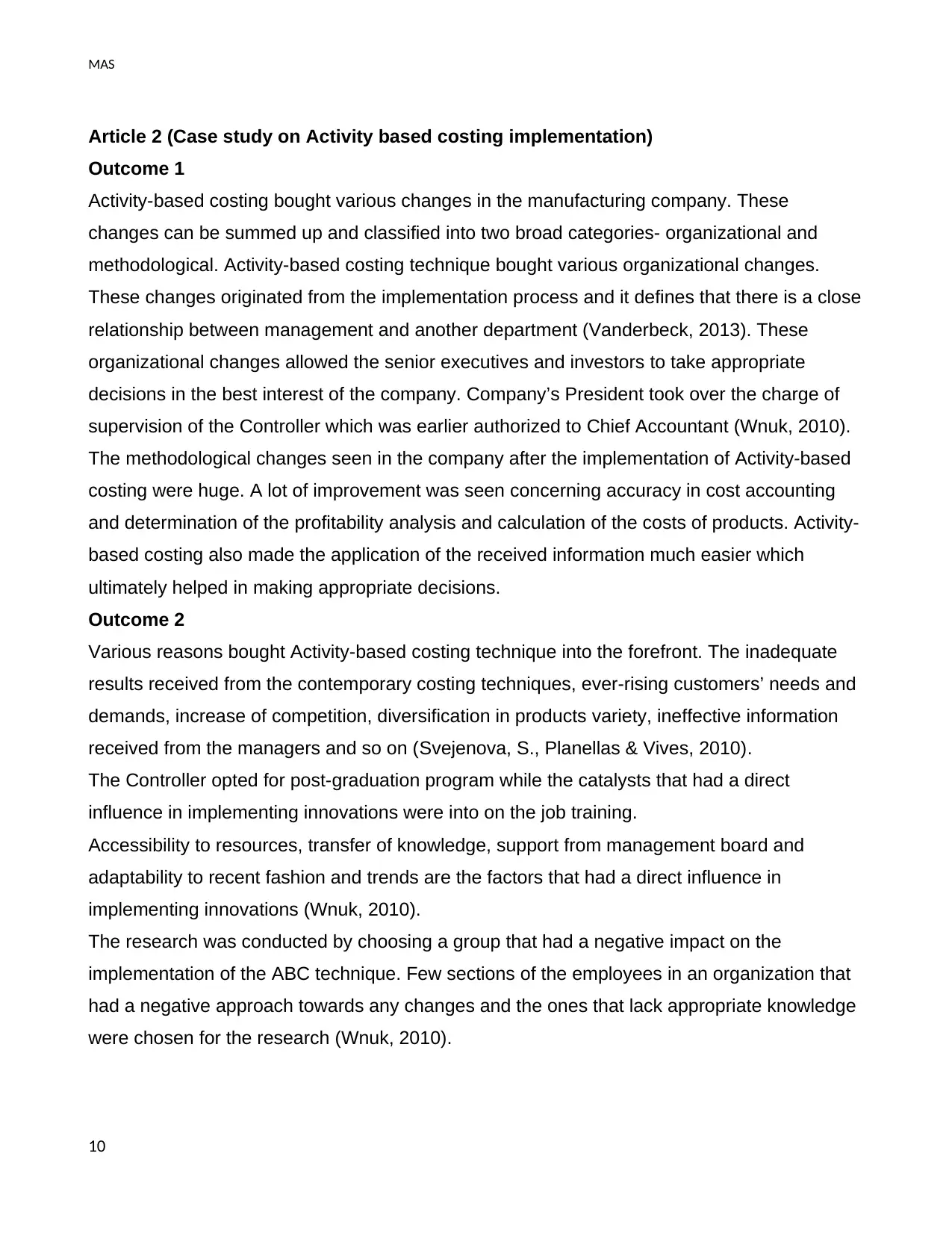
MAS
Article 2 (Case study on Activity based costing implementation)
Outcome 1
Activity-based costing bought various changes in the manufacturing company. These
changes can be summed up and classified into two broad categories- organizational and
methodological. Activity-based costing technique bought various organizational changes.
These changes originated from the implementation process and it defines that there is a close
relationship between management and another department (Vanderbeck, 2013). These
organizational changes allowed the senior executives and investors to take appropriate
decisions in the best interest of the company. Company’s President took over the charge of
supervision of the Controller which was earlier authorized to Chief Accountant (Wnuk, 2010).
The methodological changes seen in the company after the implementation of Activity-based
costing were huge. A lot of improvement was seen concerning accuracy in cost accounting
and determination of the profitability analysis and calculation of the costs of products. Activity-
based costing also made the application of the received information much easier which
ultimately helped in making appropriate decisions.
Outcome 2
Various reasons bought Activity-based costing technique into the forefront. The inadequate
results received from the contemporary costing techniques, ever-rising customers’ needs and
demands, increase of competition, diversification in products variety, ineffective information
received from the managers and so on (Svejenova, S., Planellas & Vives, 2010).
The Controller opted for post-graduation program while the catalysts that had a direct
influence in implementing innovations were into on the job training.
Accessibility to resources, transfer of knowledge, support from management board and
adaptability to recent fashion and trends are the factors that had a direct influence in
implementing innovations (Wnuk, 2010).
The research was conducted by choosing a group that had a negative impact on the
implementation of the ABC technique. Few sections of the employees in an organization that
had a negative approach towards any changes and the ones that lack appropriate knowledge
were chosen for the research (Wnuk, 2010).
10
Article 2 (Case study on Activity based costing implementation)
Outcome 1
Activity-based costing bought various changes in the manufacturing company. These
changes can be summed up and classified into two broad categories- organizational and
methodological. Activity-based costing technique bought various organizational changes.
These changes originated from the implementation process and it defines that there is a close
relationship between management and another department (Vanderbeck, 2013). These
organizational changes allowed the senior executives and investors to take appropriate
decisions in the best interest of the company. Company’s President took over the charge of
supervision of the Controller which was earlier authorized to Chief Accountant (Wnuk, 2010).
The methodological changes seen in the company after the implementation of Activity-based
costing were huge. A lot of improvement was seen concerning accuracy in cost accounting
and determination of the profitability analysis and calculation of the costs of products. Activity-
based costing also made the application of the received information much easier which
ultimately helped in making appropriate decisions.
Outcome 2
Various reasons bought Activity-based costing technique into the forefront. The inadequate
results received from the contemporary costing techniques, ever-rising customers’ needs and
demands, increase of competition, diversification in products variety, ineffective information
received from the managers and so on (Svejenova, S., Planellas & Vives, 2010).
The Controller opted for post-graduation program while the catalysts that had a direct
influence in implementing innovations were into on the job training.
Accessibility to resources, transfer of knowledge, support from management board and
adaptability to recent fashion and trends are the factors that had a direct influence in
implementing innovations (Wnuk, 2010).
The research was conducted by choosing a group that had a negative impact on the
implementation of the ABC technique. Few sections of the employees in an organization that
had a negative approach towards any changes and the ones that lack appropriate knowledge
were chosen for the research (Wnuk, 2010).
10
Paraphrase This Document
Need a fresh take? Get an instant paraphrase of this document with our AI Paraphraser

MAS
11
11
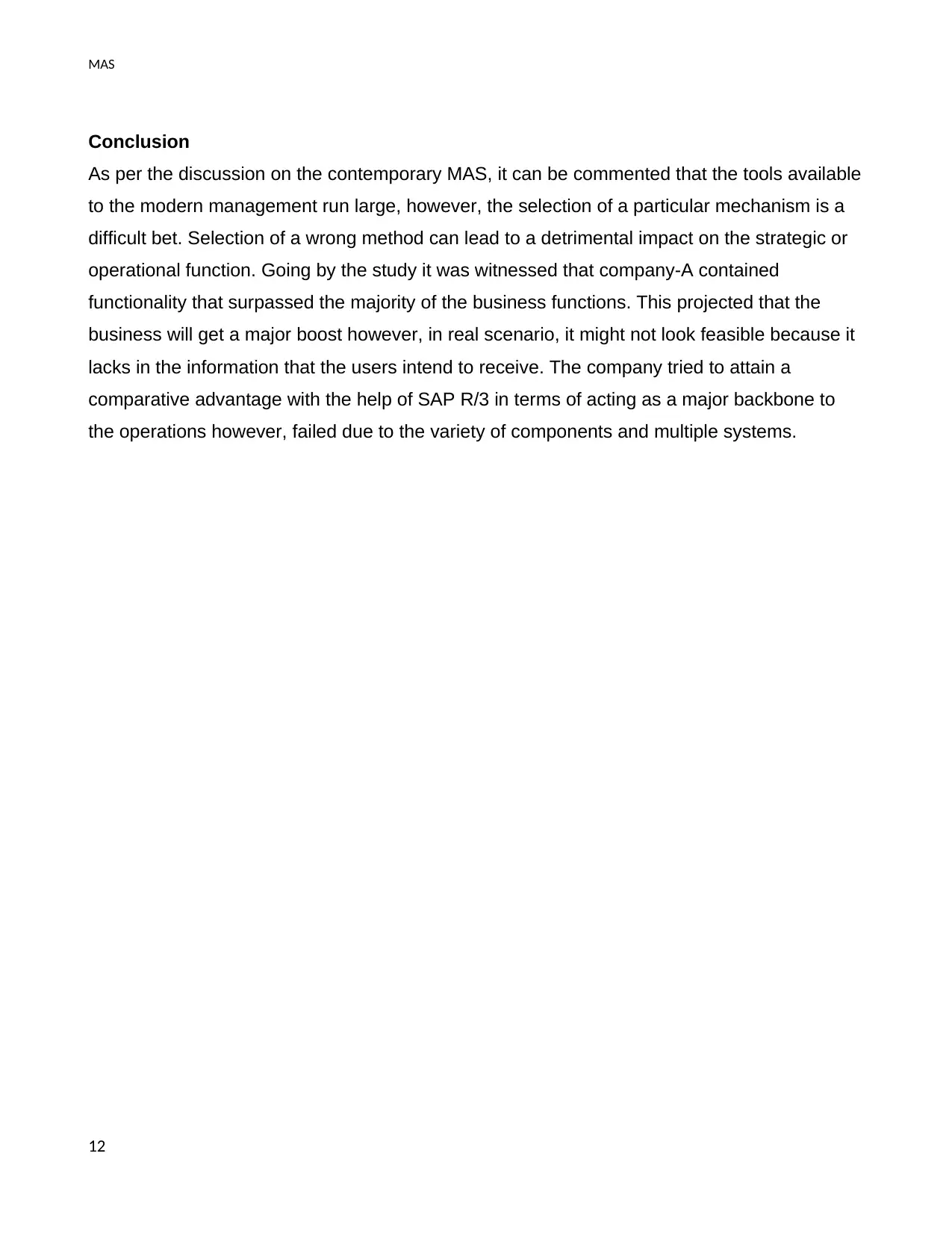
MAS
Conclusion
As per the discussion on the contemporary MAS, it can be commented that the tools available
to the modern management run large, however, the selection of a particular mechanism is a
difficult bet. Selection of a wrong method can lead to a detrimental impact on the strategic or
operational function. Going by the study it was witnessed that company-A contained
functionality that surpassed the majority of the business functions. This projected that the
business will get a major boost however, in real scenario, it might not look feasible because it
lacks in the information that the users intend to receive. The company tried to attain a
comparative advantage with the help of SAP R/3 in terms of acting as a major backbone to
the operations however, failed due to the variety of components and multiple systems.
12
Conclusion
As per the discussion on the contemporary MAS, it can be commented that the tools available
to the modern management run large, however, the selection of a particular mechanism is a
difficult bet. Selection of a wrong method can lead to a detrimental impact on the strategic or
operational function. Going by the study it was witnessed that company-A contained
functionality that surpassed the majority of the business functions. This projected that the
business will get a major boost however, in real scenario, it might not look feasible because it
lacks in the information that the users intend to receive. The company tried to attain a
comparative advantage with the help of SAP R/3 in terms of acting as a major backbone to
the operations however, failed due to the variety of components and multiple systems.
12
⊘ This is a preview!⊘
Do you want full access?
Subscribe today to unlock all pages.

Trusted by 1+ million students worldwide
1 out of 14
Related Documents
Your All-in-One AI-Powered Toolkit for Academic Success.
+13062052269
info@desklib.com
Available 24*7 on WhatsApp / Email
![[object Object]](/_next/static/media/star-bottom.7253800d.svg)
Unlock your academic potential
Copyright © 2020–2025 A2Z Services. All Rights Reserved. Developed and managed by ZUCOL.





